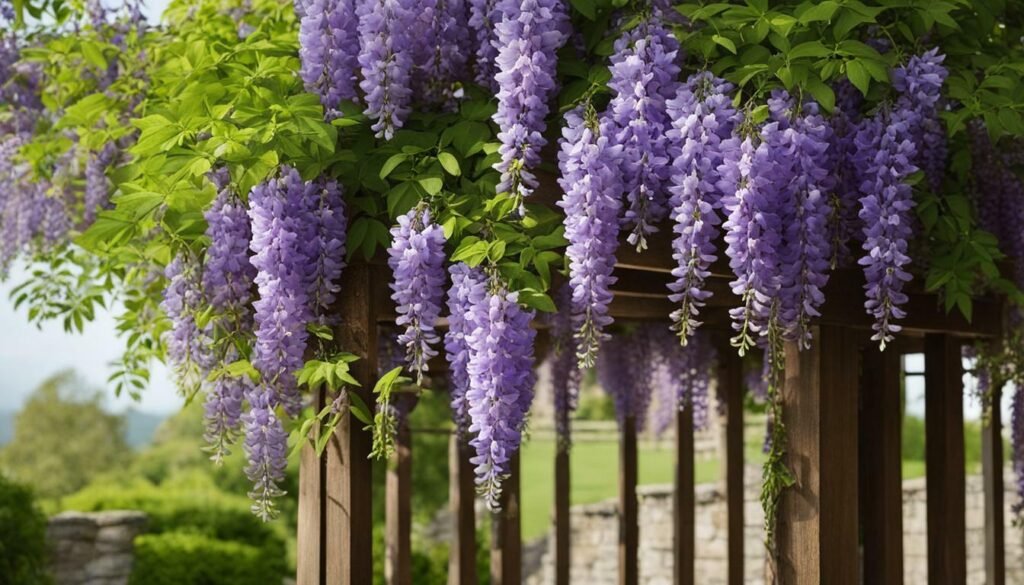Welcome to my complete guide on American Wisteria care and maintenance. If you’re looking to cultivate this beautiful vine in your garden, it’s essential to learn about its specific needs and how to promote healthy growth and blooming.
American wisteria (Wisteria frutescens) is a non-invasive and less aggressive variety of wisteria that is native to North America. It can reach up to 30 feet in height and width and produces clusters of blue flowers. American wisteria requires a strong structure for support, such as archways, arbors, fences, or trellises. It prefers full sun and moist, well-draining soil with an acidic to neutral pH. Regular pruning can encourage more flowering and should be done twice a year. Propagation can be done through cuttings taken from softwood. Invasive species of wisteria, such as Chinese and Japanese wisteria, should be avoided. Chinese wisteria blooms in early spring, while American wisteria blooms in late spring. Japanese wisteria is similar to Chinese wisteria but has more decorative flowers. Wisteria is toxic to humans and pets.
Table of Contents
ToggleKey Takeaways:
- American Wisteria (Wisteria frutescens) is a native non-invasive wisteria species in North America.
- It can grow up to 30 feet in height and width, producing clusters of blue flowers.
- American Wisteria requires a strong support structure and prefers full sun and well-draining soil.
- Regular pruning and propagation through softwood cuttings are important for promoting growth and blooming.
- Avoid invasive wisteria species such as Chinese and Japanese wisteria.
- American Wisteria blooms in late spring, while Chinese wisteria blooms in early spring.
- Wisteria is toxic to humans and pets, so precautions should be taken when planting and maintaining it.
Exploring American Wisteria: Characteristics and Growth
Let’s explore the distinct characteristics and growth patterns of American Wisteria, a species native to North America. Understanding these traits will help you create an optimal environment for this enchanting vine to thrive.
American Wisteria, scientifically known as Wisteria frutescens, is a non-invasive and less aggressive variety of wisteria. Unlike its invasive counterparts, Chinese and Japanese wisteria, American wisteria is a more manageable option for your garden. This deciduous vine can reach impressive heights of up to 30 feet, spreading its beauty with its lush foliage and stunning clusters of blue flowers.
The growth habit of American wisteria is vigorous, making it an excellent choice for creating a natural and romantic ambiance in your outdoor space. This vine requires a strong support structure, such as archways, arbors, fences, or trellises, to allow it to climb and showcase its cascading blooms. With proper care and maintenance, American wisteria can become a breathtaking focal point in your garden.
To ensure the healthy growth of American wisteria, it is crucial to provide it with the ideal growing conditions. This vine thrives in full sun exposure, basking in the warmth and light of the sun’s rays. It also prefers moist, well-draining soil with an acidic to neutral pH. By offering these optimal conditions, you can encourage vigorous growth and abundant flowering from your American wisteria.
By now, you have gained valuable insights into the distinct characteristics and growth patterns of American Wisteria. From its non-invasive nature to its cascading clusters of blue flowers, this native North American vine has the potential to transform your garden into a captivating sanctuary. Stay tuned for our next section, where we will discuss the importance of choosing the right location for your American Wisteria.

| American Wisteria Characteristics | American Wisteria Growth |
|---|---|
|
|
Choosing the Right Location for Your American Wisteria
When it comes to cultivating American Wisteria, location is key. Discover what factors to consider when choosing the perfect spot for this vine to flourish in your garden.
American Wisteria, also known as Wisteria frutescens, thrives in full sun and well-draining soil. Before planting, assess your garden to find an area that receives at least six to eight hours of direct sunlight each day. This will ensure that your wisteria receives the necessary energy to produce its vibrant blue flowers.
In addition to sunlight, the soil conditions are vital for the health and growth of American Wisteria. This vine prefers moist, well-draining soil with an acidic to neutral pH level. You can test the pH of your soil using a kit available at your local garden center. If the soil is too alkaline, you can lower the pH by adding organic matter such as compost or peat moss.
Another consideration when choosing a location for your American Wisteria is the support structure. This vine requires a sturdy structure to climb and sprawl, such as archways, arbors, fences, or trellises. Ensure that the chosen structure is strong enough to support the weight of the mature vine, as American Wisteria can reach heights and widths of up to 30 feet.
| Factors to consider: | Optimal conditions: |
|---|---|
| Sunlight exposure | Full sun (6-8 hours) |
| Soil type | Moist, well-draining, acidic to neutral pH |
| Support structure | Sturdy, able to withstand the weight of the vine |
Important Considerations
- Choose a location that receives ample sunlight throughout the day.
- Ensure the soil is well-draining and has the appropriate pH level for American Wisteria.
- Select a strong support structure to accommodate the vine’s growth.
“When choosing a location for your American Wisteria, it’s crucial to provide the optimal conditions it needs to thrive. The right amount of sunlight, well-draining soil with the correct pH level, and a sturdy support structure are key factors to consider.”
By carefully selecting the right location, you can create an ideal environment for your American Wisteria to flourish. With the right balance of sunlight, soil conditions, and support, your vine will reward you with stunning clusters of blue flowers that will enhance the beauty of your garden.
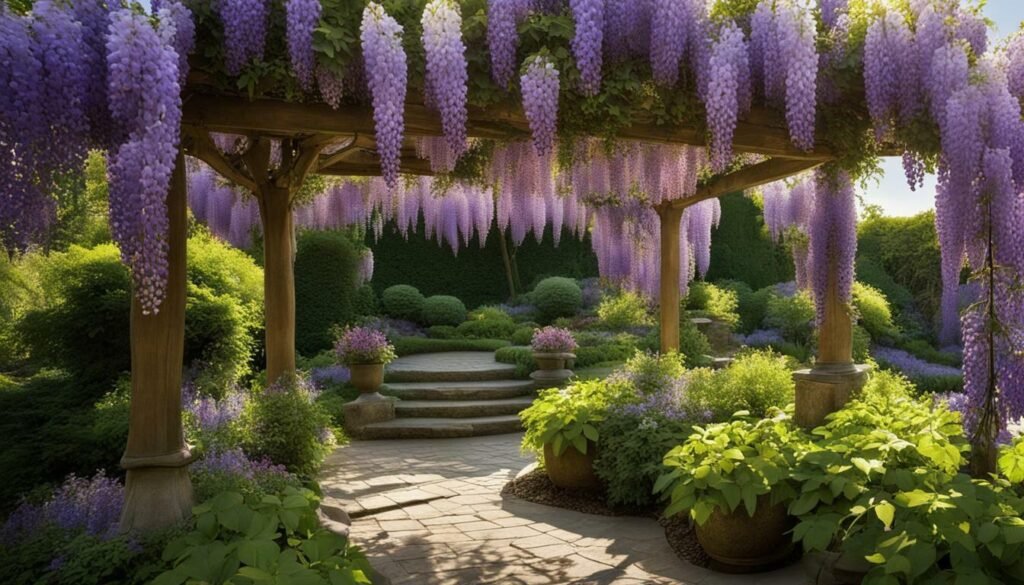
Essential Care Tips for American Wisteria
Proper care is essential to ensure the health and vibrancy of your American Wisteria vine. Learn the essential care tips that will keep your plant thriving throughout the seasons.
Watering: American Wisteria enjoys consistently moist soil, so regular watering is necessary, especially during dry spells. Aim to keep the soil evenly moist but not waterlogged. Avoid overhead watering to prevent fungal diseases. Instead, water at the base of the plant to ensure deep hydration.
Fertilizing: Feed your American Wisteria once a year in early spring with a balanced, slow-release fertilizer. This will provide the necessary nutrients for healthy growth and abundant flowering. Avoid excessive nitrogen fertilizers, as they can stimulate excessive foliage growth at the expense of flowers.
Pest and Disease Control: American Wisteria is generally resistant to pests and diseases. However, keep an eye out for common garden pests like aphids and caterpillars, which can occasionally infest the vine. Regularly inspect your plant and use appropriate organic insecticides or insecticidal soaps if necessary. Keep the vine well-pruned to promote airflow and prevent fungal diseases.
| Care Tips | Description |
|---|---|
| Sunlight | American Wisteria thrives in full sun, so choose a location that receives at least 6 hours of direct sunlight daily. |
| Pruning | Regular pruning is key to maintaining the shape of your American Wisteria and promoting better flowering. Prune once in late winter or early spring to remove dead or damaged wood, and again after flowering to control size and shape. |
| Support Structure | Provide a sturdy trellis, arbor, or pergola for your American Wisteria to climb on. The vine grows vigorously and needs strong support to prevent damage. |
| Propagation | Propagate American Wisteria through softwood cuttings taken in early summer. Dip the cuttings in rooting hormone and plant them in a well-draining potting mix. Keep them in a warm, humid environment until roots develop. |
“Proper care and maintenance are the keys to ensuring the long-term success of your American Wisteria. By following these essential care tips, you’ll be rewarded with a stunning vine that brings beauty and fragrance to your outdoor space.”
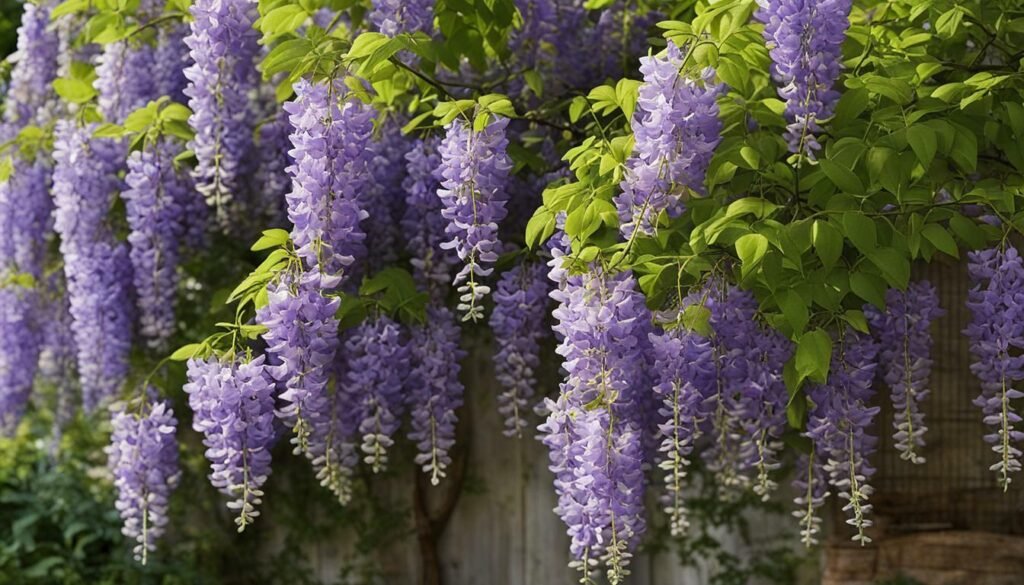
Remember that American Wisteria is a non-invasive alternative to other wisteria species. Its beautiful blue flowers and manageable growth make it a fantastic choice for any garden. With the right care and attention, your American Wisteria vine will flourish and become a captivating centerpiece in your outdoor oasis.
Pruning American Wisteria for Optimal Blooming
Pruning American Wisteria is a vital practice for encouraging optimal blooming. Discover the proper techniques and timing to ensure your vine showcases its beautiful clusters of flowers.
American Wisteria, a non-invasive and less aggressive variety native to North America, requires regular pruning to maintain its shape and promote flowering. Pruning should be done twice a year, in late winter or early spring and again in late summer. This helps to control the vine’s growth, prevent it from becoming unruly, and encourage the development of more abundant and fragrant blooms.
When pruning American Wisteria, start by removing any dead, damaged, or diseased branches. Use clean, sharp pruning shears to make clean cuts just above a bud or lateral branch. It is important to prune back the vine to maintain its desired size and shape, as American Wisteria can become quite large if left unpruned. Additionally, pruning stimulates new growth and encourages the production of more flowering spurs.
Proper timing is crucial for pruning American Wisteria:
- Winter or early spring pruning: This is the time to perform heavy pruning, removing up to 60% of the previous year’s growth. Cut back long, unruly branches to about 2-3 feet from the main stem. This encourages the formation of strong new shoots and promotes better flowering in the upcoming season.
- Late summer pruning: In late summer, after the vine has finished blooming, perform light pruning to remove any excessive growth or unwanted shoots. Prune back new growth to maintain the desired shape and size of the vine.
By following these pruning techniques and timing, you can ensure that your American Wisteria vine remains healthy, vibrant, and adorned with its stunning blue flowers. Remember to wear gloves when pruning, as the vine’s sap may irritate the skin. Happy pruning!

| Benefits of Pruning American Wisteria | Timing | Techniques |
|---|---|---|
| Encourages more abundant and fragrant blooms | Twice a year: late winter or early spring, and late summer | Remove dead, damaged, or diseased branches; prune back to control growth and maintain shape |
| Controls vine’s size and prevents unruly growth | Make clean cuts just above a bud or lateral branch | |
| Stimulates new growth and flowering spurs | Cut back long, unruly branches in winter or early spring; perform light pruning in late summer |
Propagation Methods for American Wisteria
Expanding your American Wisteria collection can be a rewarding experience. Learn how to propagate this captivating vine using simple yet effective methods. Propagation of American Wisteria can be done through cuttings taken from softwood, which refers to the new growth that is still green and flexible. This method allows you to create new plants that are genetically identical to the parent plant, ensuring the continuation of desirable traits.
To propagate American Wisteria through softwood cuttings, follow these steps:
- Select a healthy, vigorous stem with new growth that is around 4-6 inches long. Make a clean, angled cut just below a leaf node, using a sharp and sterile pruner.
- Remove the lower leaves from the cutting, leaving only a few sets of leaves at the top. This will minimize the amount of water loss and direct energy towards root development.
- Dip the bottom end of the cutting in a rooting hormone to encourage root growth. This hormone can be found at your local garden center.
- Prepare a pot with a well-draining potting mix, such as a mixture of peat moss and perlite. Insert the cutting about two inches deep into the soil, making sure it stands upright.
- Water the cutting thoroughly, ensuring that the soil is evenly moist but not saturated. Place the pot in a warm location with bright, indirect light.
- Keep the soil consistently moist and monitor the cutting for signs of new growth. After a few weeks, you should notice roots starting to form.
- Once the cutting has established a strong root system, typically after 6-8 weeks, it can be transplanted into a larger container or directly into the ground.
Transplanting and Caring for Propagated American Wisteria Plants
When transplanting your propagated American Wisteria plants, ensure they are placed in a suitable location with full sun exposure and well-draining soil. Provide a sturdy support structure, such as an arbor or trellis, for the vine to climb on as it grows. Water the plants regularly, keeping the soil evenly moist but not overly saturated.
Once established, American Wisteria plants can be pruned to promote more abundant blooming. Pruning should be done twice a year: once in late winter or early spring before new growth begins, and then again after blooming in late summer or early fall. Remove any dead or diseased wood, as well as any tangled or overcrowded branches.
With the proper care and maintenance, your propagated American Wisteria plants will reward you with their stunning clusters of blue flowers, transforming your garden into a true spectacle of nature.
| Key Points |
|---|
| American Wisteria can be propagated through softwood cuttings |
| Prepare a well-draining potting mix and use rooting hormone |
| Transplant the cutting once it has developed a strong root system |
| Provide a suitable location with full sun exposure and a sturdy support structure |
| Prune your American Wisteria plants twice a year for optimal blooming |
| Enjoy the beauty of the stunning blue flowers in your garden |
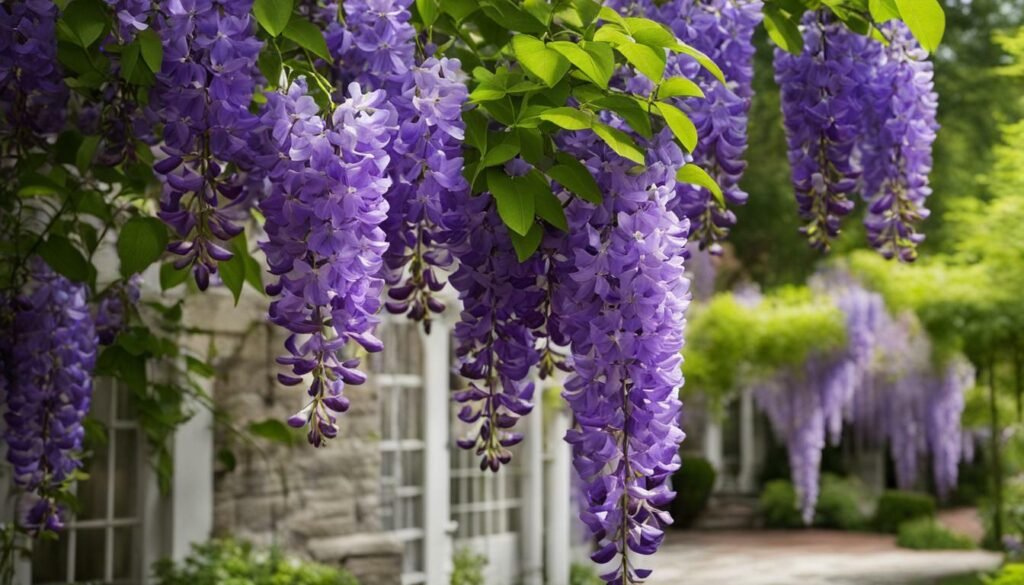
Comparing American Wisteria with Invasive Species
While American Wisteria is a native and non-invasive species, it’s important to understand the differences between it and invasive species such as Chinese and Japanese wisteria. American Wisteria, scientifically known as Wisteria frutescens, is a beautiful vine that can add a touch of elegance to any garden. It is a less aggressive variety and can reach up to 30 feet in both height and width.
Unlike its invasive counterparts, American Wisteria tends to be more manageable and easier to control. It produces stunning clusters of blue flowers and has a non-invasive nature, making it a preferred choice for many gardeners. In contrast, Chinese and Japanese wisteria, Wisteria sinensis and Wisteria floribunda respectively, can quickly take over an area and smother other plants.
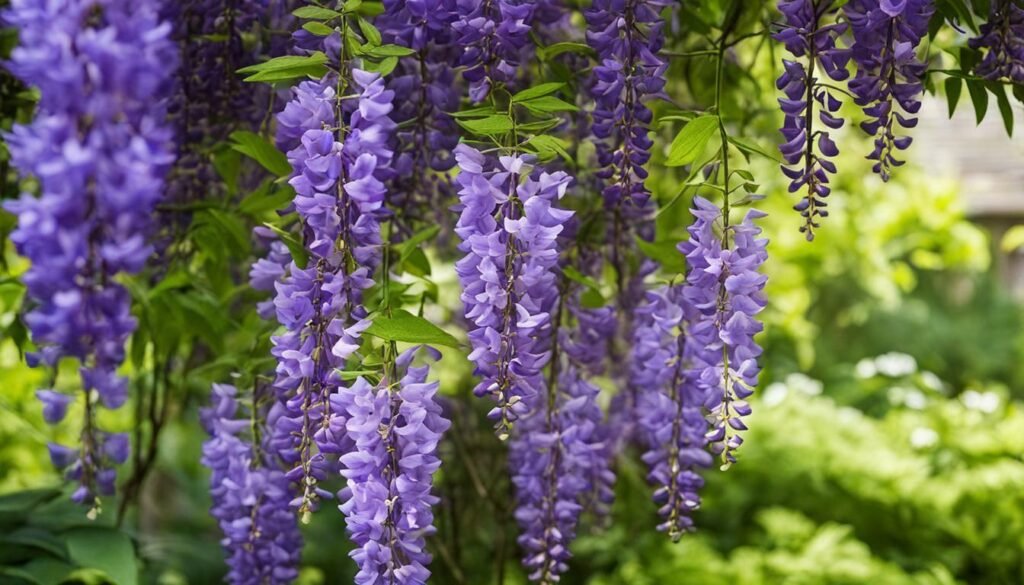
Chinese wisteria blooms in early spring, boasting clusters of fragrant flowers. However, it can become invasive, spreading rapidly and becoming difficult to contain. Japanese wisteria is similar to Chinese wisteria but is highly prized for its longer, more luxurious flower clusters. Although visually captivating, Japanese wisteria can also be invasive and should be planted with caution.
When selecting a wisteria vine for your garden, it’s crucial to choose the non-invasive American Wisteria variety. Not only will it provide you with stunning blooms, but it will also ensure that you’re not unintentionally introducing an invasive species to your environment. By opting for American Wisteria, you can enjoy the beauty of this vine without the worry of it becoming a nuisance in your garden.
Comparing American Wisteria with Invasive Species
| Species | Characteristics | Blooming Time |
|---|---|---|
| American Wisteria (Wisteria frutescens) | Non-invasive, stunning blue flowers, manageable growth | Late spring |
| Chinese Wisteria (Wisteria sinensis) | Invasive, fast-spreading, fragrant flowers | Early spring |
| Japanese Wisteria (Wisteria floribunda) | Invasive, longer flower clusters, highly decorative | Spring |
Understanding the Blooming Season of American Wisteria
Witness the breathtaking beauty of American Wisteria as we explore its unique blooming season, which sets it apart from other wisteria species. Unlike its invasive counterparts, Chinese and Japanese wisteria, American Wisteria blooms in late spring, typically from May to June. During this time, the vine becomes adorned with stunning clusters of blue flowers, creating an enchanting display that captivates any garden or landscape.
The blooming season of American Wisteria is a sight to behold, with cascades of delicate blossoms hanging from its branches. Each flower boasts a sweet fragrance that fills the air and attracts bees, butterflies, and other pollinators. The vibrant color of the blooms adds a touch of elegance to any outdoor space, making American Wisteria a popular choice among gardeners and landscape enthusiasts.
To ensure a successful blooming season for your American Wisteria, it’s important to provide the optimal growing conditions. Place the vine in a location that receives full sun exposure, as this encourages abundant flowering. Additionally, ensure the soil is moist and well-draining, with an acidic to neutral pH. Regular watering and the provision of a strong support structure, such as archways or trellises, will promote healthy growth and facilitate the development of beautiful blooms.
| Key Blooming Season Information | Optimal Conditions for Blooming |
|---|---|
| Blooming Season | Late spring (May to June) |
| Bloom Color | Blue |
| Fragrance | Sweet and captivating |
| Attracts | Bees, butterflies, and other pollinators |
In conclusion, the blooming season of American Wisteria is a sight to behold, with its stunning blue flowers and delightful fragrance. By providing the right growing conditions, you can enjoy the beauty that this wisteria species brings to your garden or landscape. So, prepare your outdoor space and get ready to be mesmerized by the enchanting blooms of American Wisteria.

Safety Considerations: American Wisteria and Toxicity
While American Wisteria is a stunning addition to any garden, it’s crucial to be aware of its toxicity to ensure the well-being of both humans and pets. The entire plant, including the flowers, leaves, and seeds, contains toxic compounds called lectins, which can cause mild to severe symptoms if ingested.
For humans, ingesting American Wisteria can lead to symptoms such as nausea, vomiting, abdominal pain, diarrhea, and dizziness. In more severe cases, it can cause difficulty in breathing, blurred vision, and even loss of consciousness. It’s important to educate yourself and your family about the potential risks and to avoid consuming any part of the plant.
Pets, especially cats and dogs, are also at risk of toxicity if they chew on or ingest American Wisteria. Symptoms may include vomiting, diarrhea, excessive drooling, abdominal pain, and lethargy. In severe cases, it can lead to kidney or liver damage. To protect your furry friends, it’s essential to keep them away from the plant and seek immediate veterinary attention if any signs of ingestion occur.
Remember, prevention is key when it comes to safety. If you decide to include American Wisteria in your garden, make sure to place it in an area that is inaccessible to children and pets. Also, consider using fencing or other barriers to prevent accidental contact. By taking these precautions, you can enjoy the beauty of American Wisteria while keeping your loved ones safe.
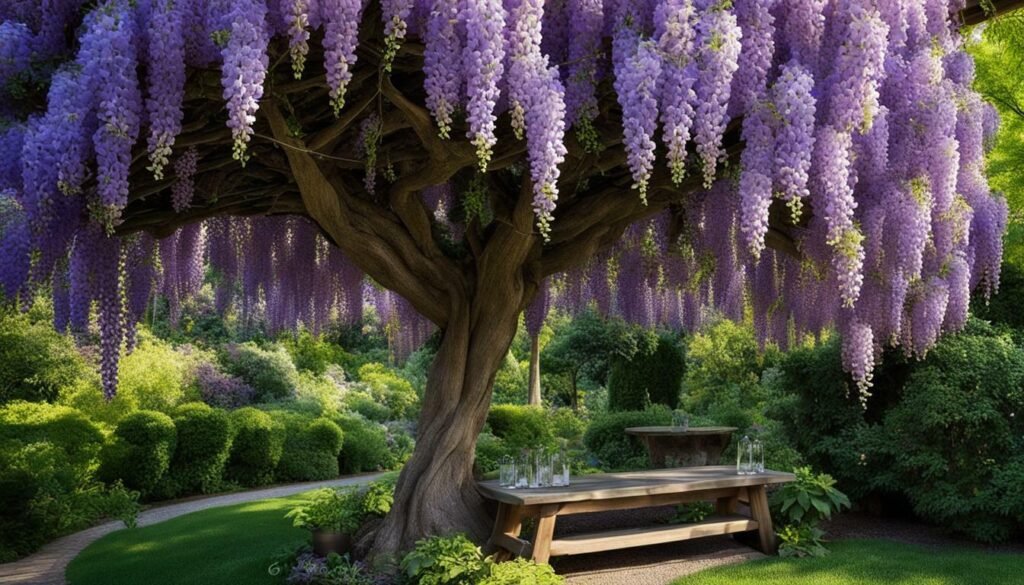
| Toxicity Symptoms in Humans | Toxicity Symptoms in Pets |
|---|---|
|
|
The Importance of Regular Maintenance for American Wisteria
Maintaining American Wisteria is a year-round commitment that yields rewarding results. Discover why regular maintenance is vital for the long-term health and beauty of this captivating vine.
American Wisteria, also known as Wisteria frutescens, is a stunning and non-invasive variety of wisteria native to North America. To ensure its optimal growth and blooming, it is essential to provide regular care throughout the year.
One of the key aspects of maintenance is pruning. Regular pruning not only helps control the size and shape of the vine but also encourages more abundant flowering. It is recommended to prune American Wisteria twice a year, once in late winter or early spring and again in mid-summer. Pruning promotes better air circulation, reduces the risk of diseases, and stimulates new growth.
In addition to pruning, maintaining proper watering and fertilization is crucial for the overall health of the vine. American Wisteria prefers moist soil, particularly during its active growing season. Regular watering, especially during dry periods, will help keep the vine hydrated and prevent stress. To provide the necessary nutrients, fertilize the vine in early spring and again in mid-summer using a balanced and slow-release fertilizer.
Protecting American Wisteria from pests and diseases is another important aspect of regular maintenance. Inspect the vine regularly for common pests like aphids and spider mites. If necessary, treat them with appropriate insecticides or insecticidal soaps. Additionally, keep an eye out for any signs of diseases such as powdery mildew or leaf spot and take prompt action to prevent their spread.
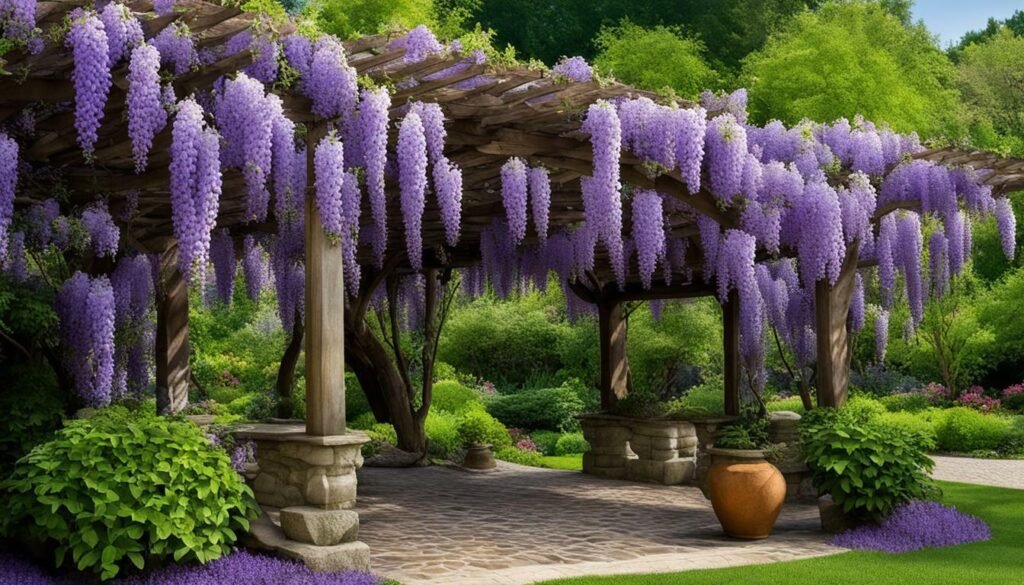
By dedicating time and effort to the regular care of American Wisteria, you can enjoy its enchanting beauty year after year. Whether it’s pruning, watering, fertilizing, or pest control, each aspect of maintenance plays a vital role in ensuring the long-term health and vitality of this captivating vine.
| Maintenance Tips for American Wisteria |
|---|
| Prune twice a year: In late winter or early spring and mid-summer to control size and promote flowering. |
| Water regularly: Keep the soil moist, especially during the active growing season. |
| Fertilize in spring and summer: Use a balanced, slow-release fertilizer to provide essential nutrients. |
| Monitor pests and diseases: Inspect the vine regularly and take appropriate action if pests or diseases are detected. |
Congratulations on completing the comprehensive guide to caring for American Wisteria.
Armed with the knowledge and tips shared, you are well-equipped to create a flourishing garden with this enchanting native vine. American wisteria (Wisteria frutescens) is a non-invasive and less aggressive variety of wisteria that is native to North America. Unlike its invasive counterparts, such as the Chinese and Japanese wisteria, the American wisteria is a beautiful addition to any garden without the fear of it taking over.
With its stunning clusters of blue flowers, reaching heights of up to 30 feet, the American wisteria is a true showstopper. To ensure its optimal growth, it’s important to provide a strong support structure, such as archways, arbors, fences, or trellises. This will allow the vine to thrive and display its vibrant blooms.
Remember to choose the right location for your American wisteria, ensuring it receives full sun exposure and is planted in moist, well-draining soil with an acidic to neutral pH. Regular pruning is essential to encourage more abundant and fragrant flowering. By following these care and maintenance practices, you can enjoy the captivating beauty of American wisteria throughout late spring.
It’s important to note that American wisteria is toxic to humans and pets, so take the necessary precautions when planting and maintaining this vine in your garden. Avoid invasive species like the Chinese and Japanese wisteria, as they can outcompete and harm the native flora. With proper care and attention, your American wisteria will reward you with its breathtaking blooms year after year.
FAQ
Is American wisteria a non-invasive plant?
Yes, American wisteria (Wisteria frutescens) is a non-invasive variety of wisteria native to North America.
How tall and wide can American wisteria grow?
American wisteria can reach heights and widths of up to 30 feet.
What color are the flowers of American wisteria?
American wisteria produces beautiful clusters of blue flowers.
What kind of structure does American wisteria need for support?
American wisteria requires a strong structure such as archways, arbors, fences, or trellises for support.
What are the preferred growing conditions for American wisteria?
American wisteria prefers full sun exposure and moist, well-draining soil with an acidic to neutral pH.
How often should American wisteria be pruned?
American wisteria should be pruned twice a year to encourage more flowering.
How can American wisteria be propagated?
American wisteria can be propagated through cuttings taken from softwood.
Should invasive species of wisteria be avoided?
Yes, invasive species of wisteria, such as Chinese and Japanese wisteria, should be avoided.
When does Chinese wisteria bloom?
Chinese wisteria blooms in early spring.
What is the difference between Japanese and Chinese wisteria?
Japanese wisteria is similar to Chinese wisteria but has more decorative flowers.
Is wisteria toxic?
Yes, wisteria is toxic to humans and pets.
